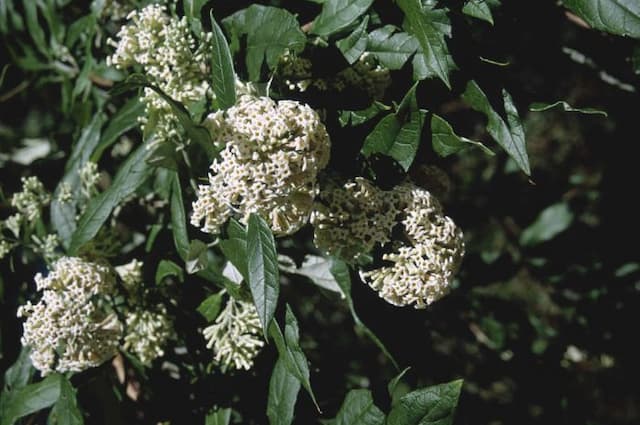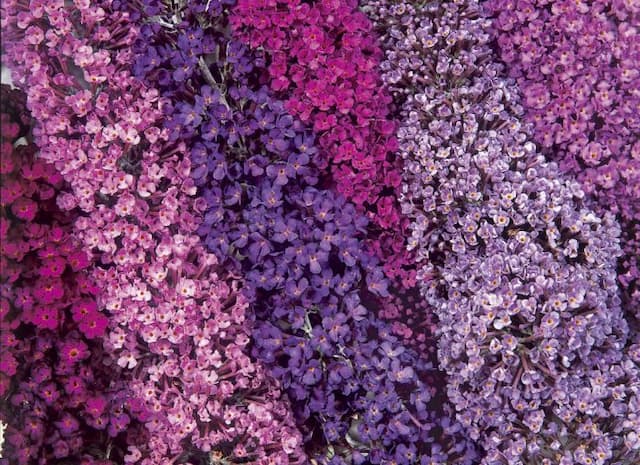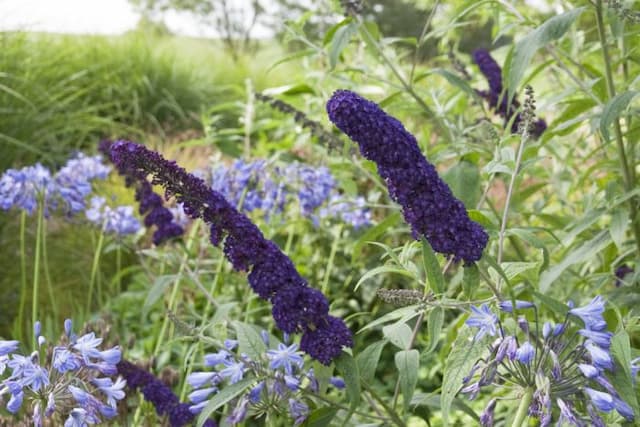Butterfly Bush Buddleja davidii 'Blue Horizon'

ABOUT
Buddleja davidii 'Blue Horizon', commonly known as the butterfly bush, is a deciduous shrub that is widely appreciated for its ornamental value and its ability to attract butterflies. This particular cultivar, 'Blue Horizon', is noted for its long, conical clusters of flowers that range in color from a deep to a bright blue, often with an orange eye in the center. These eye-catching flower panicles are composed of many tiny, tubular flowers, blossoming abundantly from early to late summer and sometimes extending into autumn. The foliage of the butterfly bush consists of lance-shaped leaves that are gray-green to dark green in color, providing a contrasting backdrop to the vibrant blue flowers. The leaves are oppositely arranged along the stems, with pointed tips and serrated margins, which give the plant a lush, textural appearance. Butterfly bushes tend to display a sprawling habit with arching branches, creating an informal and somewhat wild silhouette. The blooms are wonderfully fragrant and are a magnet for a variety of pollinators, including butterflies, bees, and hummingbirds. The overall appearance of Buddleja davidii 'Blue Horizon' is that of a robust and showy shrub, contributing splashes of cool-blue color and dynamic visual interest to gardens and landscapes.
About this plant
 Names
NamesFamily
Scrophulariaceae
Synonyms
Butterfly Bush, Summer Lilac, Orange Eye
Common names
Buddleja variabilis, Buddleia davidii, Buddleia variabilis.
 Toxicity
ToxicityTo humans
Butterfly Bush (Buddleja davidii) is generally not considered toxic to humans. There is no widely reported toxicity from ingesting parts of the Butterfly Bush, and accidental consumption is unlikely to cause serious harm. However, as with any plant, individual allergic reactions or sensitivities can occur, so it is advisable to avoid eating this plant.
To pets
Butterfly Bush (Buddleja davidii) is also not known to be toxic to pets. It is not listed on common toxic plant lists for animals such as dogs and cats, and there is no significant evidence to suggest that the Butterfly Bush poses a toxicity risk to pets. However, ingestion of any non-food plant material can potentially cause gastrointestinal upset in animals, so it's best to prevent pets from chewing on the plant.
 Characteristics
CharacteristicsLife cycle
Perennials
Foliage type
Deciduous
Color of leaves
Green
Flower color
Blue
Height
6-8 feet (1.8-2.4 meters)
Spread
4-6 feet (1.2-1.8 meters)
Plant type
Shrub
Hardiness zones
5-9
Native area
China
Benefits
 General Benefits
General Benefits- Attracts pollinators: Buddleja davidii 'Blue Horizon', commonly known as Butterfly Bush, is highly attractive to butterflies, bees, and other beneficial pollinators.
- Easy to grow: It is known for being easy to cultivate, requiring minimal maintenance and care once established.
- Drought tolerance: Once established, the Butterfly Bush is tolerant of drought, making it suitable for xeriscaping or gardens with low water availability.
- Fast-growing: This plant has a rapid growth rate, which quickly provides a full, lush shrub.
- Long blooming period: The Butterfly Bush has a long flowering season, providing color and interest in the garden from mid-summer to autumn.
- Ornamental appeal: The 'Blue Horizon' variety has striking blue-purple flowers that add a beautiful splash of color to the landscape.
- Effective for erosion control: Its root system can help stabilize slopes and banks, reducing soil erosion.
 Medical Properties
Medical PropertiesThis plant is not used for medical purposes.
 Air-purifying Qualities
Air-purifying QualitiesThis plant is not specifically known for air purifying qualities.
 Other Uses
Other Uses- Buddleja davidii 'Blue Horizon', commonly known as Butterfly Bush, can be used in natural dye production; its flowers produce subtle colors when used to dye fabrics.
- In garden design, the Butterfly Bush serves as an excellent backdrop for small perennials, creating a multi-layered aesthetic in landscape arrangements.
- Floral artists may use dried Butterfly Bush flowers to add a touch of nature to their arrangements, as they retain shape and color well.
- Buddleja davidii 'Blue Horizon' can act as a living fence when planted in rows, providing a visual barrier that is also attractive to pollinators.
- Beekeepers sometimes plant Butterfly Bush nearby as it's a nectar-rich plant that can support the local bee population.
- Some crafters hollow out the dried stems of Butterfly Bush for use in creating rustic plant stakes or for weaving into decorative garden trellises.
- Due to its fast growth, the Butterfly Bush can be used in school projects to teach children about plant biology and the attraction of beneficial insects.
- Photographers and artists might utilize Butterfly Bush as a natural backdrop for close-up photos of insects or to add "wild" element in their compositions.
- Butterfly Bush, with its arching branches, can be trained into small informal hedges for cottage-style gardens, enhancing the whimsical aspect of the garden design.
- During winter, the silhouettes of the bare branches of the Butterfly Bush can be quite striking, offering a structural element to otherwise barren landscapes.
Interesting Facts
 Feng Shui
Feng ShuiThe Butterfly Bush is not used in Feng Shui practice.
 Zodiac Sign Compitability
Zodiac Sign CompitabilityThe Butterfly Bush is not used in astrology practice.
 Plant Symbolism
Plant Symbolism- Renewal: Buddleja davidii 'Blue Horizon', commonly known as Butterfly Bush, is often associated with renewal and new beginnings because it attracts butterflies, which are symbols of transformation and change.
- Attraction: The Butterfly Bush is symbolic of attraction and allure, drawing in various pollinators and admirers with its vibrant blooms and sweet fragrance, much like one attracting positivity or beneficial relationships into their life.
- Healing: With its use in traditional medicine for its healing properties, the Butterfly Bush can represent healing and recovery, whether it be physical, emotional, or spiritual restoration.
 Water
WaterButterfly Bush (Buddleja davidii 'Blue Horizon') should be watered deeply to ensure the soil is moist but not saturated, generally receiving about 1 inch of water per week. This can be delivered in the form of rainfall or supplemental watering, with additional water during dry spells or hot weather. During the first growing season, it's crucial to maintain a consistent watering schedule to establish a strong root system. It's best to water early in the morning to reduce evaporation and give the foliage time to dry out during the day, helping to prevent fungal diseases. Once established, Butterfly Bushes are quite drought tolerant and may require less frequent watering.
 Light
LightButterfly Bushes thrive in full sun, needing at least 6 to 8 hours of direct sunlight daily. The 'Blue Horizon' performs best in a location that provides unfiltered sunlight throughout the day. It’s important to ensure that the planting spot isn't shaded by trees or buildings to maximize bloom production and plant health.
 Temperature
TemperatureButterfly Bushes are hardy and adapt well to a range of temperatures, generally preferring to grow in conditions between 60°F and 90°F. However, they can tolerate temperatures down to around 20°F. For optimal growth and flowering, maintaining a temperature within the ideal range is beneficial, but 'Blue Horizon' will survive brief temperature spikes beyond these limits.
 Pruning
PruningPruning is essential for maintaining the shape and health of the Butterfly Bush and for encouraging prolific flowering. Prune the 'Blue Horizon' in late winter or early spring before new growth begins, cutting back the previous year's growth to about a foot above the ground. This will rejuvenate the plant and stimulate the growth of new flowering shoots. Deadheading, or the removal of spent flower heads, can also be done regularly during the blooming season to promote continuous blooms.
 Cleaning
CleaningAs needed
 Soil
SoilThe Butterfly Bush (Buddleja davidii 'Blue Horizon') prefers well-draining soil enriched with organic matter. A mix of garden soil, compost, and a bit of sand or perlite aids in drainage. It thrives in a soil pH range of 6.0 to 7.0.
 Repotting
RepottingThe Butterfly Bush generally does not require frequent repotting and is often planted directly in the ground. If potted, repot every 2-3 years or when the plant appears root-bound.
 Humidity & Misting
Humidity & MistingThe Butterfly Bush is adaptable to a wide range of humidity levels and does not require any special humidity considerations as long as it is planted outside in its natural environment.
 Suitable locations
Suitable locationsIndoor
Ensure full sun exposure and well-draining soil.
Outdoor
Plant in full sun, amend soil with compost, water regularly.
Hardiness zone
5-9 USDA
 Life cycle
Life cycleBuddleja davidii 'Blue Horizon', commonly known as Butterfly Bush, begins its life cycle as a seed, which, when conditions are ideal, germinates and grows into a young seedling. The seedling then develops into a robust vegetative state, where it forms a woody structure and foliage. During spring and summer, it enters a flowering phase, producing numerous cone-shaped clusters of tiny, tubular blue flowers that attract butterflies and other pollinators. After pollination, the flowers develop into small capsules containing seeds, which are dispersed by wind, allowing the plant to propagate. In autumn, the Butterfly Bush begins to enter dormancy, reducing growth as the weather cools. Finally, the plant may die back during winter, especially in colder climates, but it will typically resprout from its base once warm temperatures return in the spring.
 Propogation
PropogationPropogation time
Spring-Early Summer
Buddleja davidii 'Blue Horizon', commonly known as Butterfly Bush, is typically propagated during late winter or early spring before new growth begins. The most popular method of propagation is by semi-hardwood cuttings. To do this, take cuttings that are 4 to 6 inches (approximately 10 to 15 cm) long from the current year's growth, ensuring each cutting has at least a couple of nodes. Strip the leaves from the lower half of the cutting and dip the cut end in rooting hormone to encourage root development. Plant the cuttings in a well-draining potting mix or a mixture of peat and perlite, ensuring the nodes where the leaves were removed are buried. Then, place the container in a warm, brightly lit area out of direct sunlight and keep the soil consistently moist but not waterlogged. Roots typically develop within a few weeks, after which the new plants can gradually acclimate to outdoor conditions before being transplanted to their final location.



![Butterfly bush [Adonis Blue]](/_next/image?url=https%3A%2F%2Fplants-admin.emdemapps.com%2Fimages%2Fplants%2F%2Fimages%2F604b56e58f983.png&w=640&q=75)

![Butterfly bush [Buzz Ivory]](/_next/image?url=https%3A%2F%2Fplants-admin.emdemapps.com%2Fimages%2Fplants%2F%2Fimages%2F604b57987dfa8.png&w=640&q=75)
![Butterfly bush [Camberwell Beauty]](/_next/image?url=https%3A%2F%2Fplants-admin.emdemapps.com%2Fimages%2Fplants%2F%2Fimages%2F604b5ead04c12.png&w=640&q=75)


